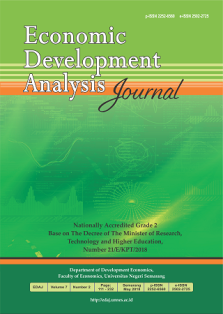Analysis of Poverty and Inequality in Java, Bali, and Lampung
Abstract
According to BPS, the largest distribution of the poor in Indonesia is on the island of Java and the surrounding provinces of Banten, West Java, Central Java, D.I. Yogyakarta, Bali and Lampung, of the total poor population in Indonesia, the Seven Provinces contributed 15.71 million to the poor.
This study aims to analyze Farmer Exchange Rates, Growth of the manufacturing sector, growth of the agricultural sector, Average Length of Education, Percentage of people working in the informal sector on poverty levels, analyze the effect of the ratio of productivity of the industrial sector to the agricultural sector, and the ratio of education to inequality income and analyze the relationship between poverty levels and income inequality in Java, Bali, Lampung. The method used is panel data analysis (pooled data) and correlation analysis as a data processing tool using the Eviews program 9. The results of this study indicate that the influence of the industrial sector is greater than the agricultural sector in reducing poverty, which is -0.47%: -0.40%. Farmer Exchange Rate (NTP) and the ratio of informal education are not significant to poverty, informal education has a positive relationship with poverty, the ratio between the productivity of the manufacturing sector compared with the productivity of the agricultural sector is significant in reducing existing inequality and the ratio of basic education level is not significant to inequality.


